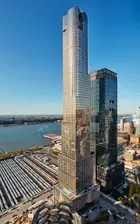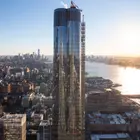After collecting rust on the Delaware River in South Philadelphia since 1996, the historic ocean liner S.S. United States may find its way back to Manhattan's Hudson River waterfront through an ambitious mixed-use redevelopment plan. The SS United States Conservancy, the nonprofit organization that owns the vessel, recently unveiled a plan for the ship's rebirth, envisioning its transformation as a permanent mixed-use fixture on Manhattan's Far West Side.
The Conservancy selected the concept from two New York firms, RXR Realty , led by Scott Rechler, and MCR Hotels to transform the ship into a permanently moored, 1,000-room hotel with multiple food and beverage destinations, several event venues, a world-class museum, and acres of new public green space.
The Conservancy has chosen a concept from two New York firms, RXR Realty and MCR Hotels, to convert the ship into a 1,000-room hotel permanently docked at Pier 76. The proposed hotel would be accompanied by multiple dining establishments, event venues, a world-class museum, and extensive public green spaces. This plan emerges as one of the last potential lifelines to rescue the ship, which currently faces the threat of eviction from its present pier in Philadelphia.
In December 2018, the nonprofit entered into an exclusive agreement with RXR to explore the redevelopment possibilities of the SS United States. This decision came after a nationwide call for potential suitors interested in saving the vessel and repurposing its 600,000 square feet of space into a self-sustaining venture.
The conceptual plan for a privately funded, commercial redevelopment identified Manhattan’s Hudson River as the optimal “home port” for the vessel, due to its proximity to transportation and pedestrian access to the Javits Convention Center. The project would entail the redesign and reconstruction of adjacent piers, which would create acres of new public green space aboard the vessel and adjoining areas. The press release notes, that the ship’s transformative potential is not restricted to New York and other locations, and port cities could benefit from the ship’s commercial revitalization and iconic status.
RXR and MCR, in collaboration with U.S. shipyards, conducted comprehensive schematic design work, extensive engineering assessments, and construction feasibility studies. They also conducted a financial analysis to showcase the project's economic viability and assessed the necessary permits and regulations to move forward with the redevelopment program. The project team involved Gibbs & Cox, the original design firm for the vessel, as well as architects from Perkins Eastman and HLW, along with local land use and regulatory counsel.
The Conservancy is now actively seeking interest from both state and local authorities, not only in New York but also in other potential cities, to support their plan for a host pier location. To expedite the progress toward the ship's revitalization, the nonprofit organization and its development team are willing to donate the ship and all the completed design and engineering work to date.
Built in the years following World War II as a testament to American optimism, ambition, power, and technical prowess, the S.S. United States was constructed with American labor and received partial funding from federal resources. The ship used no wood throughout to prevent fire, and could quickly be converted into a military vessel. It had the ability to move 14,000 troops across the Atlantic in 48 hours, without having to refuel. The design of its propellers and its top speed were kept a state secret for years. One of these propellers is currently on view at the head of Pier 76.
During its maiden voyage from New York to London in 1952, the ship achieved a speed record, securing its place as the fastest ocean liner ever built. It still holds the Blue Ribbon for the quickest westbound transatlantic crossing, completing the journey in 3 days, 12 hours, and 12 minutes at an average speed of 35.59 knots (41 mph).
Affectionately known as "America's Flagship" and referred to as "the most famous ship that didn't sink," the SS United States is also the largest ocean liner ever constructed in the United States. Characterized by its two iconic red, white, and blue funnels and streamlined design, the ship spans 990 feet from stem to stern, which is 200 feet longer than the Titanic. At full capacity, the vessel could comfortably accommodate over 2,000 passengers and a crew of 1,100, occasionally including three orchestras.
Would you like to tour any of these properties?
Just complete the info below.
Or call us at (212) 755-5544
Throughout its 17 years of service, the ship transported four American presidents, numerous heads of state, military and business leaders, immigrants, and Hollywood stars, such as John F. Kennedy, Walt Disney, Marilyn Monroe, and John Wayne. After completing 400 transatlantic crossings, the ship was retired in 1969, as the surging popularity of jet-age airlines had significantly reduced travel time to Europe, diminishing the appeal of transatlantic voyages that took days instead of mere hours.
Renderings reveal the ship's possible mooring location at Pier 76 (West 36th Street), situated near the historic United States Lines' terminal at Pier 86 (West 43rd Street). The pier is located across the West Side Highway from the expanded Javits Center with its green roof, south of the Midtown West intermodal ferry terminal, and in proximity to Hudson Yards and the High Line. While the pier is currently integrated into Hudson River Park, it had previously served as a city tow-pound until the state evicted the city in 2021 at the request of then-Governor Andrew Cuomo.
The project, still in its early stages, offers various design concepts that seem to extend the High Line from Hudson Yards to the pier and the ship. However, a law that prevents additional pier square footage from casting direct shadows on the Hudson River, may necessitate the removal of sections of the existing pier to accommodate the permanently moored vessel. If a New York City location is finalized, a gauntlet of community and government reviews is likely to follow.
Over the years, several plans have been proposed for the ship's restoration or repurposing, including office space, hotels, event centers, and casinos. However, these plans have often stalled due to the substantial operational costs of the vessel and the extensive restoration required. In 2016, the conservancy estimated the ship's conversion cost to be between $50 and $200 million, in addition to the $2 million expense for towing the vessel from Philadelphia to New York, which has likely increased since then.
The urgency to develop a viable plan to save the ship has grown recently, as the ship is at risk of eviction from its current Philadelphia pier. The rent for the ship's berth space was doubled to $1,700 per month - which still sounds like a steal for a ship that is nearly as long as the Chrysler Building is high. The project is expected to create over 5,700 jobs and further stimulate economic activity on Manhattan's far west side, where several redevelopment schemes are planned including the overhaul of the Port Authority Bus Terminal and the second phase of Hudson Yards with a possible casino license.
“The Conservancy’s partners and passionate supporters from across the country and around the world have created a viable path forward to save the SS United States,” said Susan Gibbs, president of the SS United States Conservancy and the granddaughter of the ship’s original designer. “But we are quickly running out of time. We know this can be a viable, transformative project. Let’s rally together to secure a home for America’s Flagship.”
The city has recently shown a renewed ability to think on a grand scale, with significant progress made in long-anticipated plans related to our airports, the Gateway Project, and the Second Avenue subway. The hotel proposal may also capitalize on the city's stricter regulations on Airbnb and short-term rentals, which have already caused hotel room prices to rise. Additionally, the city's recent legislation, signed by former mayor Bill de Blasio, restricts as-of-right hotel construction in many areas, thereby limiting future competition. Manhattan may be the ship's last hope, as it could be the only hotel market where such a costly project could be economically viable. However, navigating the layers of local, state, and federal red tape remains a challenge for this ambitious vision.
Would you like to tour any of these properties?
Just complete the info below.
Or call us at (212) 755-5544
Would you like to tour any of these properties?



 6sqft delivers the latest on real estate, architecture, and design, straight from New York City.
6sqft delivers the latest on real estate, architecture, and design, straight from New York City.
